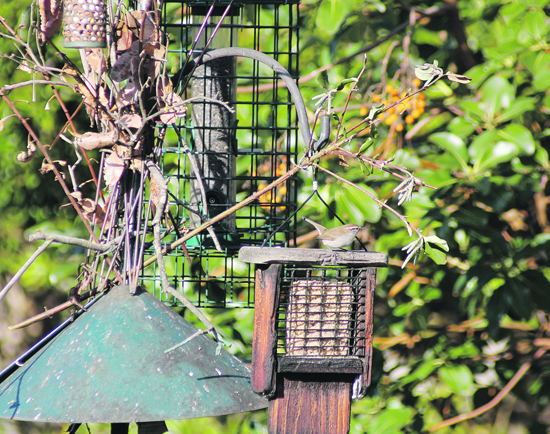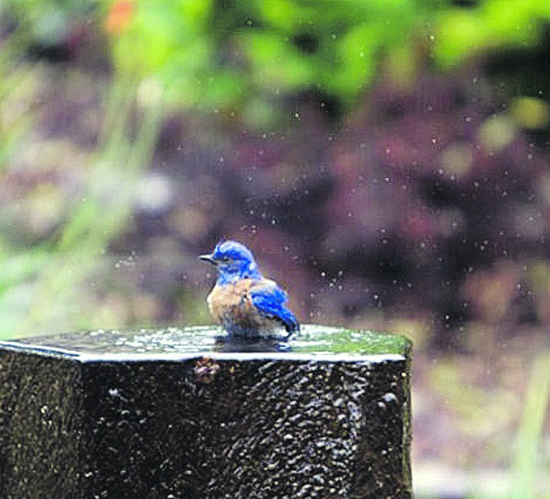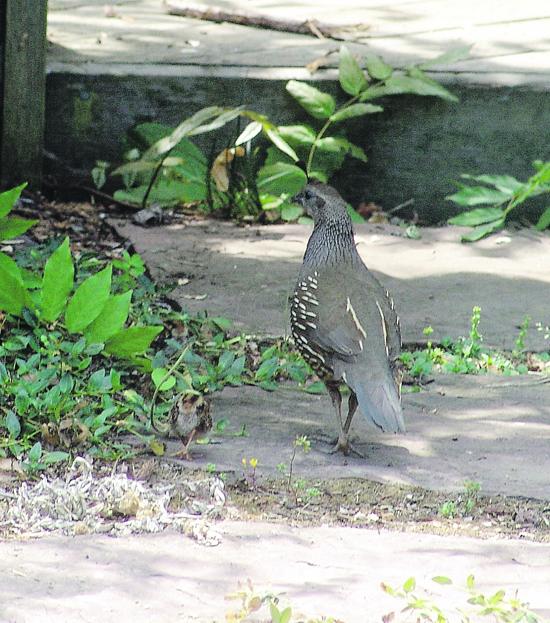| | Published April 11th, 2012
| Attracting Birds to the Native Back Yard
| | By Sophie Braccini |  | | A Bewick's wren in Al Kyte's garden Photos Al Kyte
|
A couple of chickadees fed to their little hearts' content on a suet feeder, unaware of the couple of humans, Bill and Claire Gilbert, observing them from their breakfast nook.
 They flew away, soon to be replaced by a woodpecker and later a nuthatch. Pigeons arrived at the nearby bog for their daily baths. A hawk (Sharp-shinned) was once spotted bathing in that gravel-filled bog. Attracting birds to a backyard is a constant source of pleasure and awe for those who know how to do it. Three local garden owners, featured in the May 6 Bringing Back the Natives Garden Tour, share a conviction that a native landscape is the most favorable to attract our winged friends.
They flew away, soon to be replaced by a woodpecker and later a nuthatch. Pigeons arrived at the nearby bog for their daily baths. A hawk (Sharp-shinned) was once spotted bathing in that gravel-filled bog. Attracting birds to a backyard is a constant source of pleasure and awe for those who know how to do it. Three local garden owners, featured in the May 6 Bringing Back the Natives Garden Tour, share a conviction that a native landscape is the most favorable to attract our winged friends.
 "Thirty years ago I went to a class on birds taught at the UC Berkeley Extension," reminisces Moraga gardener Al Kyte. "The presenter said that the native plants are the best environment for birds to come to gardens. It made a lot of sense to me, and that's how my passion for gardening with native plants began." Kyte is a veteran advocate and teacher of native gardening who's been featured in the Tour for years. He believes that there are a lot of elements to attracting birds to a backyard.
"Thirty years ago I went to a class on birds taught at the UC Berkeley Extension," reminisces Moraga gardener Al Kyte. "The presenter said that the native plants are the best environment for birds to come to gardens. It made a lot of sense to me, and that's how my passion for gardening with native plants began." Kyte is a veteran advocate and teacher of native gardening who's been featured in the Tour for years. He believes that there are a lot of elements to attracting birds to a backyard.
 Water is essential according to Lafayette resident Bill Gilbert. "Probably the biggest attractant has been the waterfall, bog, and pond we had installed," he said. "The year-round source of drinking water is very important to birds, especially during the dry summer months when water sources are few and far between." Gilbert and his wife Claire observe that the sound of falling water seems to act as a magnet for some bird species, especially warblers.
Water is essential according to Lafayette resident Bill Gilbert. "Probably the biggest attractant has been the waterfall, bog, and pond we had installed," he said. "The year-round source of drinking water is very important to birds, especially during the dry summer months when water sources are few and far between." Gilbert and his wife Claire observe that the sound of falling water seems to act as a magnet for some bird species, especially warblers.
 Bird feeders are also a must to please the winged guests (in different forms and with different feeds depending on what is to be attracted); one can also procure nesting boxes, but that is not enough.
Bird feeders are also a must to please the winged guests (in different forms and with different feeds depending on what is to be attracted); one can also procure nesting boxes, but that is not enough.
 "The overall design of the plantings may be the most important element," says Kyte. "A design that provides a wide variety of nesting sites, cover, and feeding options has the potential for bringing in the most species." Kyte has worked to develop a backyard concept of an oak and pine woodland with some areas of open space. "Oaks and pines each attract species that might not otherwise come, and dense shrubbery offers protection from predators and weather and draws reclusive birds, such as Spotted Towhee and Hermit Thrush," he said. "The berries from certain shrubs attract additional birds, including Cedar Waxwings and robins. Low flowering plants bring hummingbirds as well as ground-feeding birds. Providing some open ground is critical to quail, doves and bluebirds."
"The overall design of the plantings may be the most important element," says Kyte. "A design that provides a wide variety of nesting sites, cover, and feeding options has the potential for bringing in the most species." Kyte has worked to develop a backyard concept of an oak and pine woodland with some areas of open space. "Oaks and pines each attract species that might not otherwise come, and dense shrubbery offers protection from predators and weather and draws reclusive birds, such as Spotted Towhee and Hermit Thrush," he said. "The berries from certain shrubs attract additional birds, including Cedar Waxwings and robins. Low flowering plants bring hummingbirds as well as ground-feeding birds. Providing some open ground is critical to quail, doves and bluebirds."
 Orinda gardener Elizabeth O'Shea says that thinking about how plants flower is also important. "There are lots of things that bring birds to gardens. We are lucky to have a large lot bordering Moraga Creek, near open space," she says. "We have planted native plants over a twenty year period. We do try to have plants that flower over long periods and that hold seeds for a while. We also have water for the birds, bird nest boxes and feeders. We spend a lot of time watching the bird with binoculars."
Orinda gardener Elizabeth O'Shea says that thinking about how plants flower is also important. "There are lots of things that bring birds to gardens. We are lucky to have a large lot bordering Moraga Creek, near open space," she says. "We have planted native plants over a twenty year period. We do try to have plants that flower over long periods and that hold seeds for a while. We also have water for the birds, bird nest boxes and feeders. We spend a lot of time watching the bird with binoculars."
 Gilbert agrees. "Of course, vegetation on a property is very important to birds for natural food, natural nesting sites, and cover to avoid predators. We have documented Nuttall's Woodpeckers nesting in natural cavities in our Valley Oaks, and other cavity nesters likely also have nested," he says. "Regarding value as a food source, studies have shown that when non-native shrubs and trees are planted in an area, far fewer species of insects come to them than to the native shrubs and trees." And less insects, mean less birds.
Gilbert agrees. "Of course, vegetation on a property is very important to birds for natural food, natural nesting sites, and cover to avoid predators. We have documented Nuttall's Woodpeckers nesting in natural cavities in our Valley Oaks, and other cavity nesters likely also have nested," he says. "Regarding value as a food source, studies have shown that when non-native shrubs and trees are planted in an area, far fewer species of insects come to them than to the native shrubs and trees." And less insects, mean less birds.
 To find out more about the gardens and the birds, go to Bringing Back the Natives Garden Tour web site at www.bringingbackthenatives.net. The Tour is on Sunday, May 6, registration ends mid-April. The Tour is free, but donations are appreciated.
To find out more about the gardens and the birds, go to Bringing Back the Natives Garden Tour web site at www.bringingbackthenatives.net. The Tour is on Sunday, May 6, registration ends mid-April. The Tour is free, but donations are appreciated.

|
 | | A bird rests in Elizabeth O'Shea's garden
Photos courtesy of the Bringing Back the Natives Garden Tour
|  | | A quail with her chick
|  | | The Gilberts' garden is enhanced by a water feature that draws thirsty birds
| | | | | | | Advertisement
| | |
| | | print story
Before you print this article, please remember that it will remain in our archive for you to visit anytime.
download pdf
(use the pdf document for best printing results!) | | | Comments | | |
| | | | | | | | | | | | | | | | |





